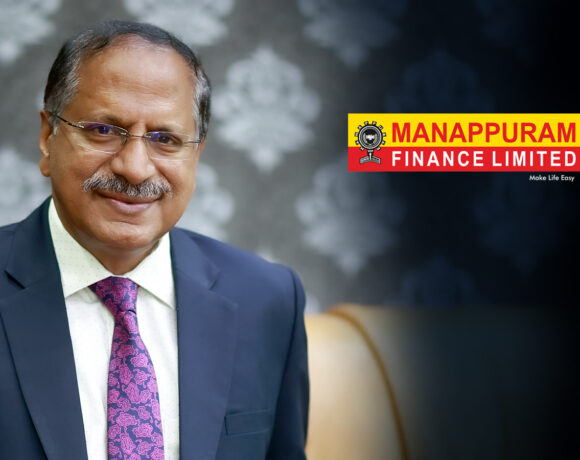NBFCs are digitalizing inclusive growth – V.P.Nandakumar

As a developing country with a large part of its population facing poverty, driving financial inclusion has been a key priority for the government of India.Financial access underpins economic opportunity. As economic growth picks up, financial inclusion becomes essential for making the growth process equitableand to ensure that its fruits are widely distributed. In India, the major reasons for financial exclusion are poverty and low income levels, financial illiteracy, high transaction cost, and the lack of infrastructure, especially IT infrastructure. The banking system and the ‘priority sector’ lending mechanism have been widely used in the past to try and extend the reach of formal credit institutions. However, while the global average of adult population with an account (at a bank, financial institution or with mobile money providers) is about 62 percent, India lags behind at about 53 percent.
Against this backdrop, there is no denying the importance of NBFCs in complementing the banking sector and reaching out to provide credit to the un-banked sections of society. Indeed, it is the ability to tap the unbanked customer base that lies at the heart of the growth story of India’s NBFCs. Most credit seekers in India lack documentary proofs of income as they work mostly in the unorganized sector or the cash economy. When data in the traditional format is not available, adoption of digitisation and recourse to digital (including social media) data become inevitable.
The Digital Strategy
The benefits of digital finance—financial services delivered through mobile phones or the internet—have been widely noted. Digital strategy is enabling NBFCS to reach out to new target segments faster than ever before. Technology imparts scalability to businesses, enabling greater reach into under-penetrated markets. The availability of accurate and real-time information leads to faster decision making and reduced turnaround time for loan disbursements. It cuts down on the need for human intervention, thereby making approval, disbursal and repayment processes faster, simpler and less error-prone. Besides, better compliance with lending regulations, more efficient tracking of customer transactions, and reduced operational expenses are some of the other benefits of the use of technology. Importantly, with digital technologies enabling the extension of financial services at much lower cost, the activity becomes more profitable. This has the direct effect of boosting efforts towards financial inclusion as catering to the limited requirements of the poor becomes worthwhile when lower cost makes the whole effort profitable.
Digital finance, therefore, has the potential to provide access to financial services for poor people in India who would otherwise not be of interest to mainstream players in the financial sector. It can significantly increase the volume of loans extended to individuals and businesses. In recent years, along with data, smartphones too have become more affordable, and these have become game changers for digital finance. India has the world’s second largest internet population. It is also the biggest smartphone market after China and mobile phone penetration is growing quickly. Mobile payments can lower the cost of providing financial services by 80 to 90 percent, enabling providers to serve lower income customers profitably.
In 2016, India introduced another innovation called India Stack which is described as “a series of secured and connected systems that allows people to store and share personal data such as addresses, bank statements, medical records, employment records and tax filings and which also enables the digital signing of documents.”The data can be accessedand shared via Aadhaar biometric authentication.The India Stack framework will make the new digital economy work seamlessly and it has created the ecosystem in which financial institutions can offer consumers access to all financial products on their mobile phones by enabling presence-less, paperless and cashless service delivery. With the ability to operate in real time, transactions such as making loans or opening a bank account that earlier took a few days to complete are now instantaneously performed through a fingerprint or retina scan.
This world-class infrastructure is poised to drive innovation in financial services and financial inclusion in the years to come. The India Stack infrastructure includes e-Sign, e-KYC (Know Your Customer) via OTP (One Time Password), DigiLocker, Unified Payment Interface (UPI). It can also be extended to eNACH or electronic National Automated Clearing House (which allows automated recurring payments by customers). These tools allow one to authenticate identity, sign documents electronically, provide proof of age, and set up electronic EMI instructions. When combined with mobile internet and paperless financial services, it has the potential to transform India into a technology leader of the world. It may be mentioned here that most developed countries do not have government-owned and managed secure infrastructure for instant identity verification, or signing documents electronically.
Thanks to this digital infrastructure, India is poised to leapfrog the rest of the world in financial services delivery by ensuring that every citizen can access any financial product almost instantaneously on their mobile phones,without paper, cash or physically signing documents. The government has enabled the infrastructure with foresightand an eye on financial inclusion, and without compromising on information security.
Technology and the next phase of growth for gold loan NBFCs
Until now, the leading gold loan NBFCs have been using information technology mainly to improve operations efficiency. This was achieved by building a centrally managed application that is simultaneously accessed by all branches for each and every transaction.Moreover, the gold loan business has traditionally run on a branch-based model due to the physical collateral involved which makes it necessary for the customer to visit the branch for valuation and storage. The model also involves a fair amount of physical paperwork and therefore the related inefficiencies are inevitably a part of the process. However, with technology interventions, there is an opportunity to make these processes efficient and paperless.
Information gathering by data entry through pen and paper often result in a higher turn-around-time and error-prone data. The solution is the use of chatbots and RPA (robotic process automation) for the customer on-boarding process, so that most of the application data is filled up by chat botswithout much human intervention. Tools like chatbots and voice bots that will not only help reduce operations spend but will also provide consistent experience to customers. When supplemented with image processing software to read off details from standard government documents such as Voter-ID, PAN card etc., the process of filling a loan application form becomes easier.
One important part of the gold loan business has so far been left out of the ambit of technology, and that is the lockers.Lockers are an essential and critical component of the gold loan business. Currently, due to the necessity of having to open the lockers frequently, the keys to the lockers are held with branch staff who operate within a vicinity of five meters from the locker during working hours. For obvious reasons, this is a major security risk. To manage this risk, a possible solution would be the use of IoT (internet of things) based eLockers integrated into the centralserver through the IT network. The eLockers can only be opened by making a request through the system followed-up by a One Time Password (OTP). These eLockerswould be entirely managed (be it opening, closing, auditing, remote monitoring etc.) by encrypted IT systems. This will enhance security of the gold stored in it. Besides, the use of M2M (machine to machine) communications protocol will enable remote monitoring of the stored gold.
The business of lending money against gold jewellery is an age old activity whose practices remained unchanged and bound in tradition for many, many years. Things changed only with the entry of the gold loan NBFCs in the nineties, particularly after Manappuram Finance Ltd. entered the gold loan business. We were the pioneers in introducing technology to this ancient activity and injecting modern management practices to scale up the business. Today, as India’s financial services sector stands on the cusp of another technology revolution, gold loan NBFCs will be seen at the vanguard.
(V.P. Nandakumar is MD & CEO of Manappuram Finance Ltd. Views are personal.)
Photo Courtesy : Google/ images are subject to copyright











